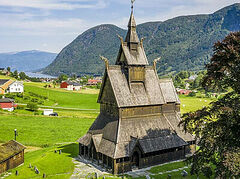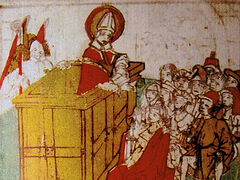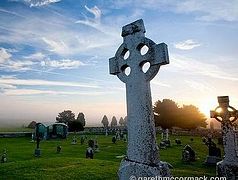Part 1: Early Figures, Missionaries, and Martyrs
Part 2: Holy Hierarchs
Part 3: Hermits and Ascetics
Part 4: Great Monastic Founders
Part 5: Holy Women
 The city of Rouen in the Middle Ages. Photo: jeanmarieborghino.fr
The city of Rouen in the Middle Ages. Photo: jeanmarieborghino.fr
St. Leo of Rouen (†c.900)
St. Berthevin of Lisieux (†c.1000)
St. Girald of Fontenelle (†c.1029)
The last period of Normandy’s history relevant to this discussion falls in what can properly be called its Norman era. Starting as early as the late 8th century—but concentrated principally in the 9th and 10th—a succession of raids from the Viking Northmen (“Nortmanni”) wrought considerable devastation across much of northwestern France. Cities and monasteries (which were particularly attractive and convenient targets) were ravaged. Unable to cope for long and stem this tide, the Carolingian kings of France eventually gave way to the invaders of the area. The Viking chief Rollo took control of an area that became the Duchy of Normandy. He accepted baptism and became the first Norman ruler. These events prompted a large Scandinavian immigration to the region, placing a permanent and distinctive stamp upon it. That this region remained Orthodox for a while even at this late juncture can be inferred from the continued presence of saints on its soil; it is also worth noting here that the holy martyr king St. Olaf Haraldsson of Norway (†1030) received baptism in Rouen in the year 1010, and showed a preference for Norman clerics in the Christian evangelization of his home country.
The final few saints to be featured here were active during this period and its aftermath. Despite their recency relative to the other saints featured here, however, we have few details other than a few highlights from their lives; nonetheless, their holiness is such that even these meager gleanings are rich with edifying and inspiring content.
The first of these late figures, the holy hieromartyr St. Leo of Rouen, actually attained the crown of martyrdom far from Normandy, in the city of Bayonne in the extreme southwest of France. However, he was born in the Normandy region and served as bishop there, so his tie to this region is substantial.
Born in the mid-9th century, about 856, in the rural village of Carentan on the northeastern part of the Cotentin Peninsula, for his great piety and wisdom St. Leo was elevated to the bishopric of Rouen. Sometime thereafter he undertook missionary work and labored dauntlessly in evangelizing the Navarre and Basque regions. While this engaged, he was martyred by beheading at the hands of Saracen (presumably Moorish) pirates near the Spanish border. A spring of healing water miraculously sprang from the site of his martyrdom and, like some of the other cephalophore martyr saints mentioned above, he miraculously carried his head to another location, delivering, per tradition, a final sermon before reposing. This was in the year 900.
St. Berthevin of Lisieux was a native of Bayeux, where he served for some time as a priest. Norman Viking incursions forced him to flee southward to Laval. There he became involved in court life as tutor to the children of the count. However, his predilection was always for solitary prayer and religious contemplation, which he alternately pursued at a nearby pond or in the church of St. Nicholas in Mayenne. His piety and devoutness, however, put him at odds with certain corrupt and worldly figures at court, who came to see him as threat to their schemes and iniquitous activities. They therefore contrived to have him killed, thus placing him among the martyrs. St. Berthevin’s feast is celebrated on June 11th, and two communes in France bear his name.
The final figure chronologically that we will feature here was of a very late era in the Orthodox history of Western Europe, living up to just a couple of decades before the West’s tragic Schism. This is St. Girald of Fontenelle, one of the last great figures in the once so brilliantly glorious history of that venerable establishment. As with the other saints in this section, though, we have little by way of details about his life—just a general sketch, really.
St. Girald (alternately Gerard) is said to have been a native of Mantois (possibly Boinville-en-Mantois in north-central France). He was reared in holiness and received a presumably quite excellent education in the cathedral school at Chartres under the tutelage of St. Filbert of Chartres (†1028). St. Girald later followed his mentor, the monk Herbert, to the Abbey of St. Peter in Lagny-sur-Marne, on the River Marne, a once venerable establishment originally founded by the Irish monk St. Fursey of Burgh Castle (†650) in the 7th century. There St. Girald received monastic tonsure and later went forth, at his teacher’s behest, to found a monastery at Crépy-en-Valois near Paris (presumably the Priory of Saint-Arnoul, in which case he would have been a re-founder of it along Benedictine lines in the early 11th century, though this is mainly attributed to a certain Count Walter II).
 Our Lady of Fontenelle. Statue from the early 14th century
Our Lady of Fontenelle. Statue from the early 14th century
St. Girald is most enduringly noted and venerated for his abbacy of the great abbey of Fontenelle. He held this post from 1006 until his death in either 1029 or 1031. Here he showed great skill, wisdom, and piety. However, life at Fontenelle had apparently sadly declined from its erstwhile excellence. For St. Girald’s close fidelity to the monastic rule and exacting standards seemingly provoked a backlash amongst certain less pious brethren. St. Girald also provoked the enmity of a wicked nobleman whose misdeeds the holy abbot fearlessly opposed. Things came to such a head that a disgruntled monk, driven apparently to madness from hatred of the holy man, murdered St. Girald one night in his sleep. This tragic circumstance aroused, however, deep piety and compunction within the other monks, who almost immediately came to regard their slain abbot as a martyr, for which he is enduringly venerated.
Through these late figures in the Orthodox history of the Normandy region, we see how the light of holiness remained unextinguished up until almost the very end as the darkness of falsehood and schism enveloped the West. Even though northern France and surrounding areas were, sadly, primary epicenters of this lamentable process, nonetheless holy people still emerged from this darkening milieu. They thus shine forth to us today all the more brilliantly, like isolated stars against the dark night sky. May we be blessed by their holy prayers!
Conclusion
Normandy is much more than just a scenically beautiful tourist destination in France. Its history is far more than just the famous Allied landing on D-Day during World War II. It is most assuredly more—by far—than the tragic and still greatly lamentable Conquest of England in 1066 and the destruction of English Orthodoxy. For centuries a vast multitude of saints of every sort of vocation, social position, and special spiritual gifts enriched and sanctified this land, providing it with a veritable galaxy of heavenly intercessors. That is the true and enduring history and value of this area. From the early Christian centuries, and even for a time after the takeover by the Viking Normans, up nearly until the Schism, this land produced holy people. And it is to be hoped that, as the 20th century saw the revival of an Orthodox presence on French soil through Russian emigrés and the great St. John Maximovitch, this presence will grow and blossom in our own time through the intercessions of France’s numerous saints—among whose company the region of Normandy is well represented indeed!



